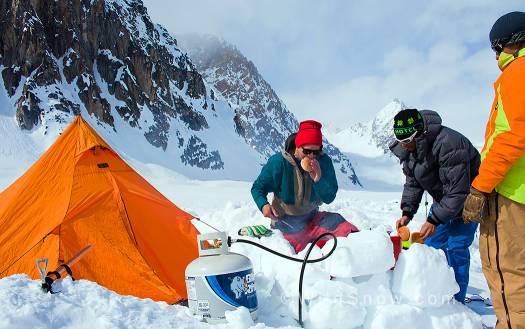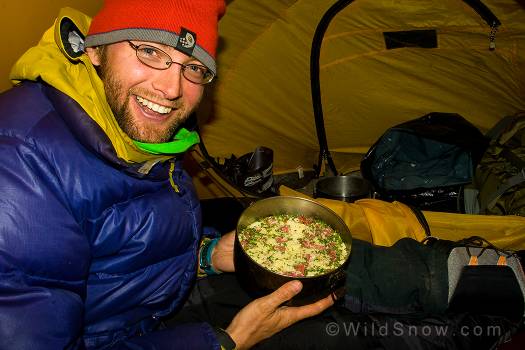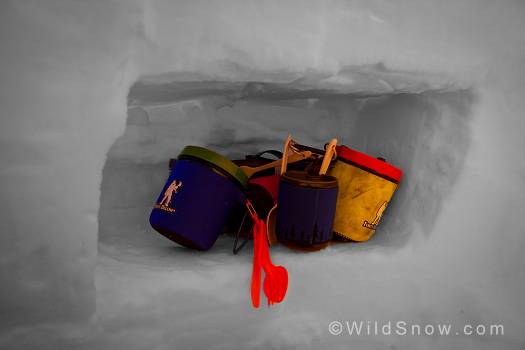When I talk to people about the many ski mountaineering expeditions I have been on, one of the first questions is: “What do you eat?” Well, food obviously. The real answer is not that simple. Numerous factors must be considered when planning food for an expedition: taste, nutrition/calories, weight, ease of preparation and more.
Taste
It is important to make food that you actually look forward to eating. If you don’t like the food that you have, you won’t eat that much of it, which will adversely affect your ability to perform at high physical output. This is especially true at altitude and cold weather. For the SkiTheBig3 expedition and on Mt. Hayes we went with some more exotic cuisine to break up the routine.
Breakfasts are easy for me. It is my favorite meal. I love eggs and hash browns and anything mixed in with them. There are many types of powdered eggs that are surprisingly good. For these two trips we went with Ova Easy Egg Crystals. Highly recommended.
Lunch is another easy one. It has to be simple and easy to eat throughout the day. We mixed a bunch of Honey Stinger products (chews, waffles, and bars) in with different types of trail mix, Cheese-It or Wheat Thin crackers, and a Snickers bar.
Dinner can be tricky. It is easy to fall into a routine where everything tastes the same. The key is diversity. Pad thai, curry and other Indian foods were mixed in with the regulars like burritos, quesadillas and pasta. This ensured that it would at least take a little longer to get bored with our dinners. I think it is also important to eat a hot dinner to help with staying warm while sleeping. That may just be in my head, but it works for me.
Calories/Nutrition
There are many different viewpoints as to how many calories are needed per day for an expedition. I imagine it depends on what you are actually doing day-to-day. Since I am mostly in cold weather environments and high altitude I prescribe to the idea that there cannot be a limit. The higher the calorie count the better. When in a cold high altitude environment your body is eating an absurd amount of calories while at rest. It is using a ton of energy to keep warm as well as fighting effects of the altitude. Then add in the fact that for long periods of time you will be exerting yourself at a high level. On the Kahiltna and Mt. Hayes we ate roughly 4,000 to 6,000 calories a day.
Nutrition is another important factor (and something we emphasize here at WildSnow dot com). You can easily dump a ton of calories into your body, but if it’s all junk food it is not going to do your body good. Just like at home, it is important to eat well rounded meals. Carbs, proteins, fats and sugars all need to be taken into account. This is obviously harder to do on an expedition, especially when you need to carry everything on your back, but it is certainly possible. Dehydrated foods make it easier. I always try to make sure that meat (or a meat equivalent, high in protein) and veggies are put into breakfast and dinner. Lunch usually consist of lots of grains, and sugars. Grains like couscous and pasta are great for dinner; they help fill you up.
Weight
For most expeditions the food that you bring will have to be carried with you. This complicates things. Bringing well rounded meals packed with calories that also taste good can get heavy really fast. Luckily the amount of dehydrated foods available is incredible. The trick is finding what tastes good. Meat, veggies, eggs, tomato sauce, and anything else can be found. Then it is just a matter of spices and what to put them with. Couscous is great. It is super light and fast to make and can be made with basically anything. When weight is less of an obstacle, for instances like base camp meals, Tasty Bites Indian Food is amazing. They taste great and are easy to make.
For Mt. Foraker on the SkiTheBig3 expedition we had to carry about 6 days worth of food in our pack. Weight was of the utmost importance. Here is what we brought:
Ease of Preparation
After a long day of climbing that last thing you want to have is an in depth, time consuming meal prep. Anything that can be made fast is key. Having hot soup before every dinner is wonderful. It gives you something to start on while the rest of dinner is being made, and helps to hydrate as well.
Freeze dried Thanksgiving dinner is a favorite. Tasty Bites packages can just be put in boiling water to cook. Couscous is quick. Add water and let it sit for 5 minutes and you are done. There are some days where this is not too much of an issue, like storm or rest days where all you have is time to prep your meal.
For the most part you don’t want to spend hours cooking when you could be sleeping. Organization is key. Finding ingredients and measuring things out is not fun to do when you feel like death. Everything should be ready to go before you even start your trip.
What we did on the SkiTheBig3 trip was prepare everything in Anchorage. We measured everything out and separated it into days. So a breakfast, a lunch, and a dinner for all four of us was put into a bag and labeled. This way each morning we could just grab a bag and have our food all ready for the day.

Ski Plane Base Camp in the Tordrillos. When the plane takes all your food in and you have to carry nothing you can go big with food prep. Double bacon cheeseburgers on a glacier are pretty tasty.
Readers, we know many of you are experienced multi-day expedition skiers. What are your food tricks? Nutella? Celery? How do you deal with individual likes and dislikes? Leave comments.
Stock up on Honey Stinger here.
WildSnow.com guest blogger Anton Sponar spends winters enjoying the Aspen area of Colorado, while summers are taken up with slave labor doing snowcat powder guiding at Ski Arpa in Chile. If Anton didn’t ski every month and nearly every week of the year, skiing would cease to exist as we know it.


